Apply - Interfolio
{{$ctrl.$state.data.pageTitle}} - Apply - Interfolio
Giulia Brancaccio and I are looking for a pre-doc to work with us on topics related to Industrial Organization and Trade
@nyu.edu
Ideally for two years starting in September
apply.interfolio.com/165860
#EconSky #EconRA
15.04.2025 00:57 — 👍 14 🔁 7 💬 0 📌 0
Thanks Jeff!
12.03.2025 10:04 — 👍 0 🔁 0 💬 0 📌 0
Thanks!!
08.03.2025 17:51 — 👍 0 🔁 0 💬 0 📌 0
Thanks Jake :)
08.03.2025 17:51 — 👍 0 🔁 0 💬 0 📌 0
Likewise!!
08.03.2025 17:51 — 👍 1 🔁 0 💬 0 📌 0
Thanks Steve!
08.03.2025 17:51 — 👍 0 🔁 0 💬 0 📌 0
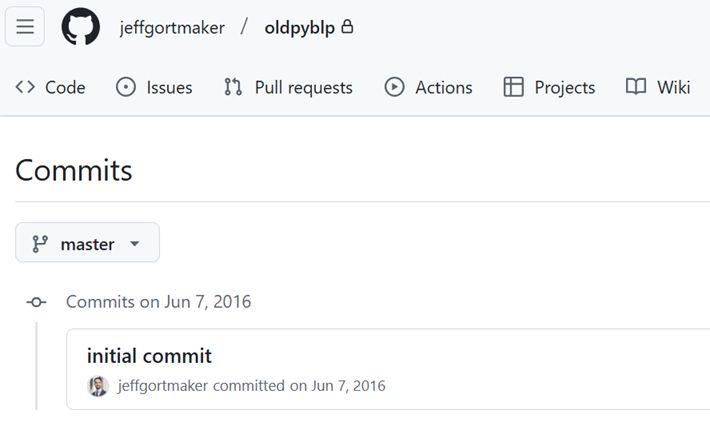
My job market's done, and I'm heading back to the NYC area! Excited to join Princeton Econ as a postdoc next year and NYU Stern Econ as an AP in 2026.
In a happy twist of fate, this means @cconlon.bsky.social and I will be colleagues exactly 10 years after our first PyBLP commit:
07.03.2025 22:34 — 👍 47 🔁 2 💬 5 📌 0
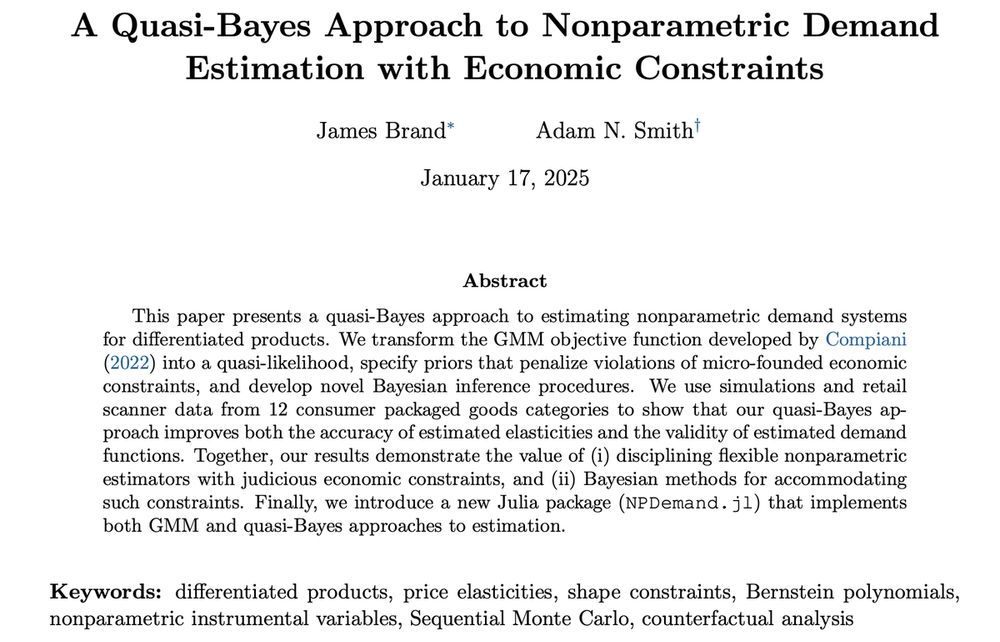
New paper with @adam-n-smith.bsky.social
papers.ssrn.com/sol3/papers....
Our paper develops a new approach for estimating demand nonparametrically while imposing economic constraints and comes with a new package, NPDemand.jl! Some things we do in the paper 1/
17.01.2025 15:46 — 👍 36 🔁 10 💬 3 📌 1
7/6 Also: I'm on the job market! If you're interested in the economics of (industrial policy for) open source or want to see a (very simple) example of PyBLP-powered micro BLP in action, check out my job market paper: bsky.app/profile/jeff...
29.11.2024 15:50 — 👍 4 🔁 0 💬 1 📌 0
6/6 All this to say: if you're doing methods research, there are some clear private benefits that can come jointly with doing open source work (impact, transparency, networking, etc.) but also others that could be more surprising.
29.11.2024 15:50 — 👍 1 🔁 0 💬 1 📌 0

GitHub - Mixtape-Sessions/Demand-Estimation: Demand Estimation taught by Jeff Gortmaker and Ariel Pakes
Demand Estimation taught by Jeff Gortmaker and Ariel Pakes - Mixtape-Sessions/Demand-Estimation
5/6 Having an open source package lets you show students exactly how the method works with real-time examples. I used PyBLP to teach one of @causalinf.bsky.social @kylefbutts.bsky.social's Mixtape sessions (github.com/Mixtape-Sess...), which would have been far less accessible without it.
29.11.2024 15:50 — 👍 3 🔁 0 💬 1 📌 0
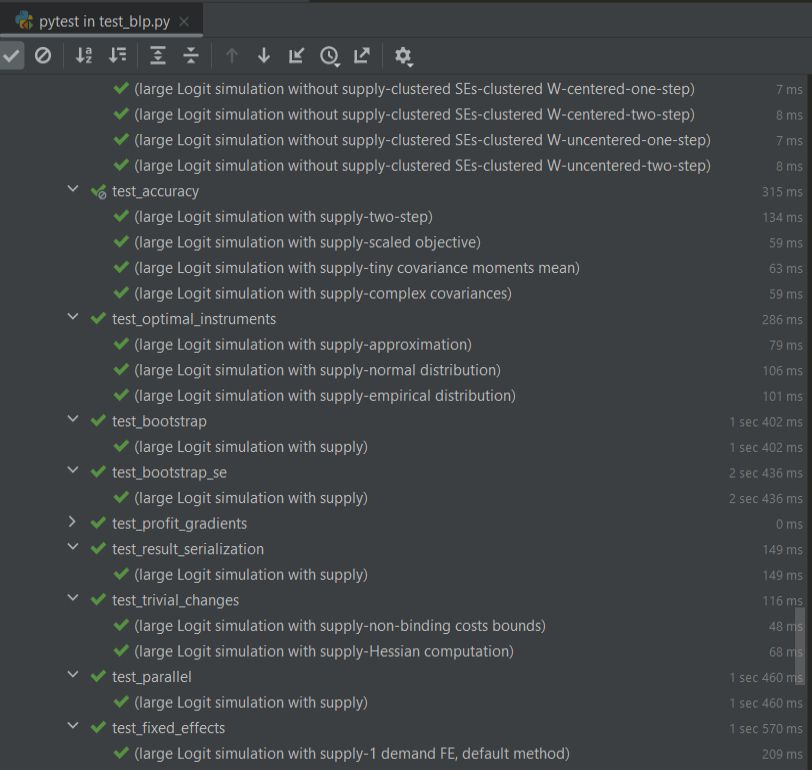
4/6 When others rely on your code, you write more tests, which can benefit your (future) self. For every PyBLP version, I run ~2k tests across ~50 functions. These made it easy to broaden the scope of our papers by adding new simulations and empirical examples with confidence.
29.11.2024 15:50 — 👍 2 🔁 0 💬 1 📌 0
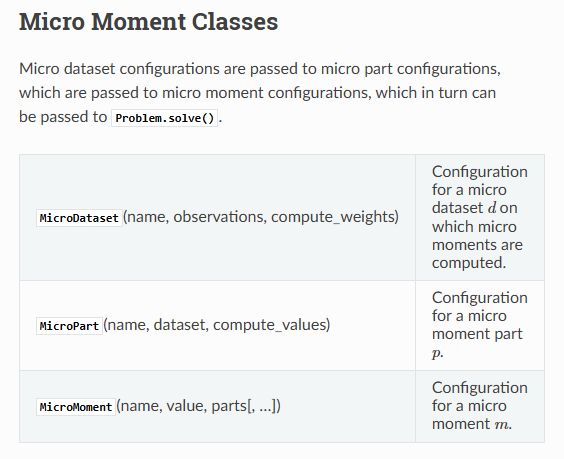
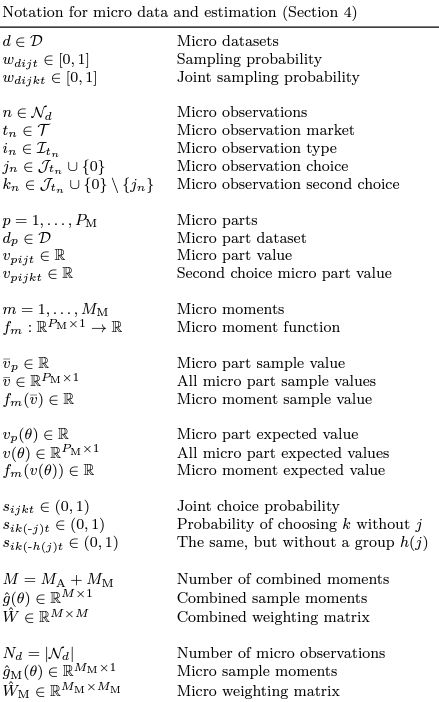
3/6 For micro BLP, I spent time iterating on PyBLP's interface to balance usability and flexibility. Feedback from users helped improve my design, which mapped directly into our standardized econometric framework, a key contribution of the 2nd paper.
29.11.2024 15:50 — 👍 2 🔁 0 💬 1 📌 0
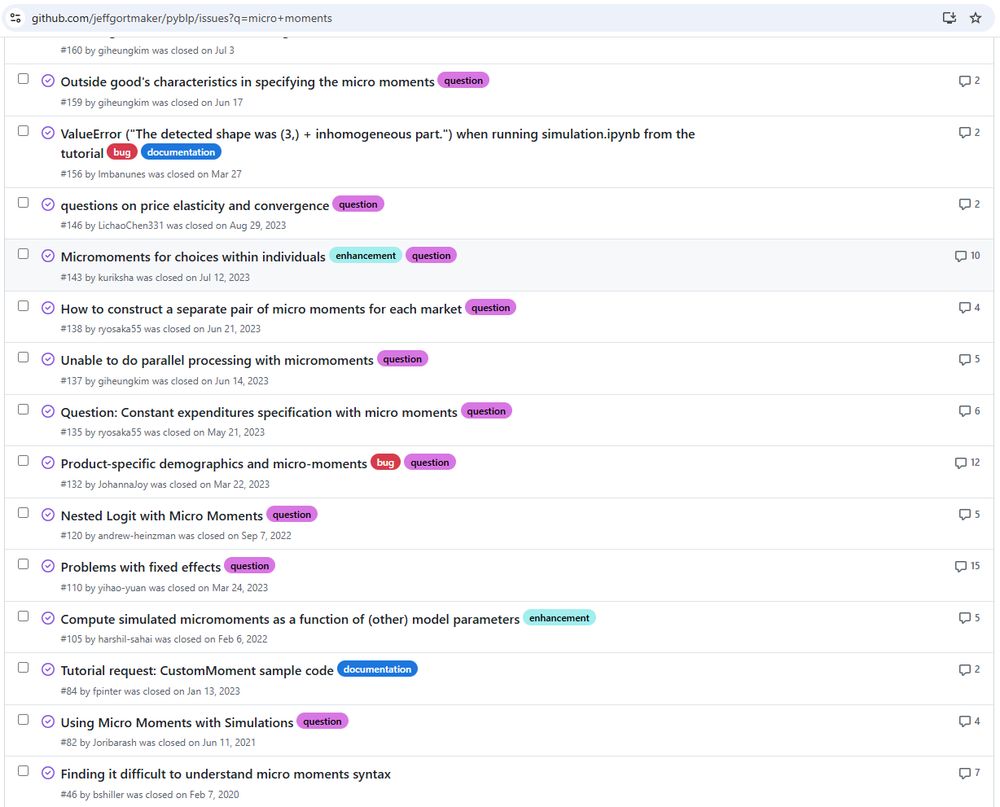
2/6 I expected PyBLP's issue tracker (github.com/jeffgortmake...) to be mostly bug reports, but most are questions. Our 2nd paper was motivated by these interactions, and many of our explanations were informed by discussions on the tracker and emails from less vocal users.
29.11.2024 15:50 — 👍 2 🔁 0 💬 1 📌 0
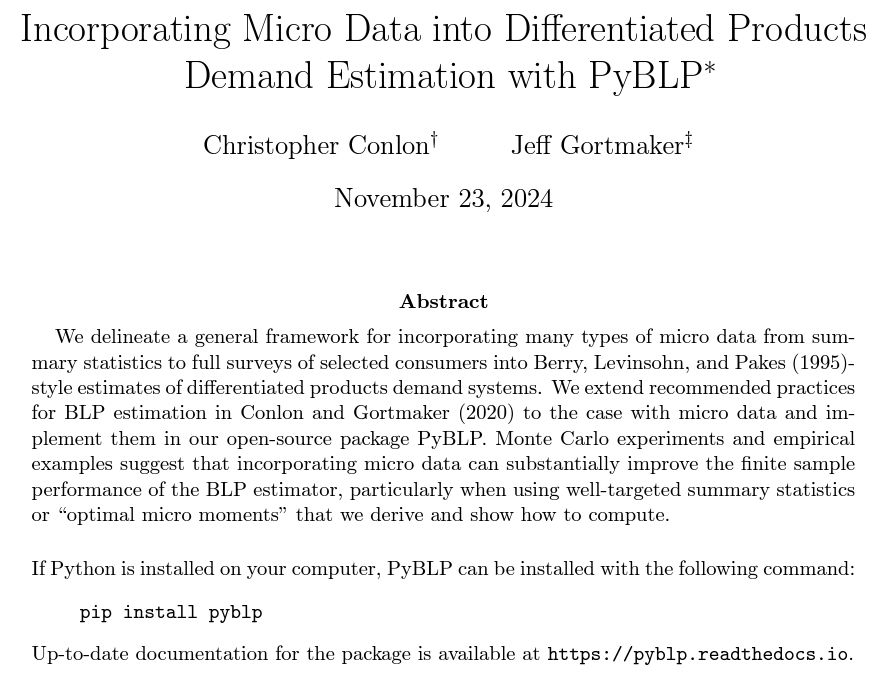
Happy to share that my and @cconlon.bsky.social's micro BLP paper was just accepted at the Journal of Econometrics! jeffgortmaker.com/files/Incorp...
It's our 2nd tied to our PyBLP software, so here's a thread on surprising (to me) benefits of combining methods research with open source work. 1/6
29.11.2024 15:50 — 👍 54 🔁 20 💬 2 📌 1
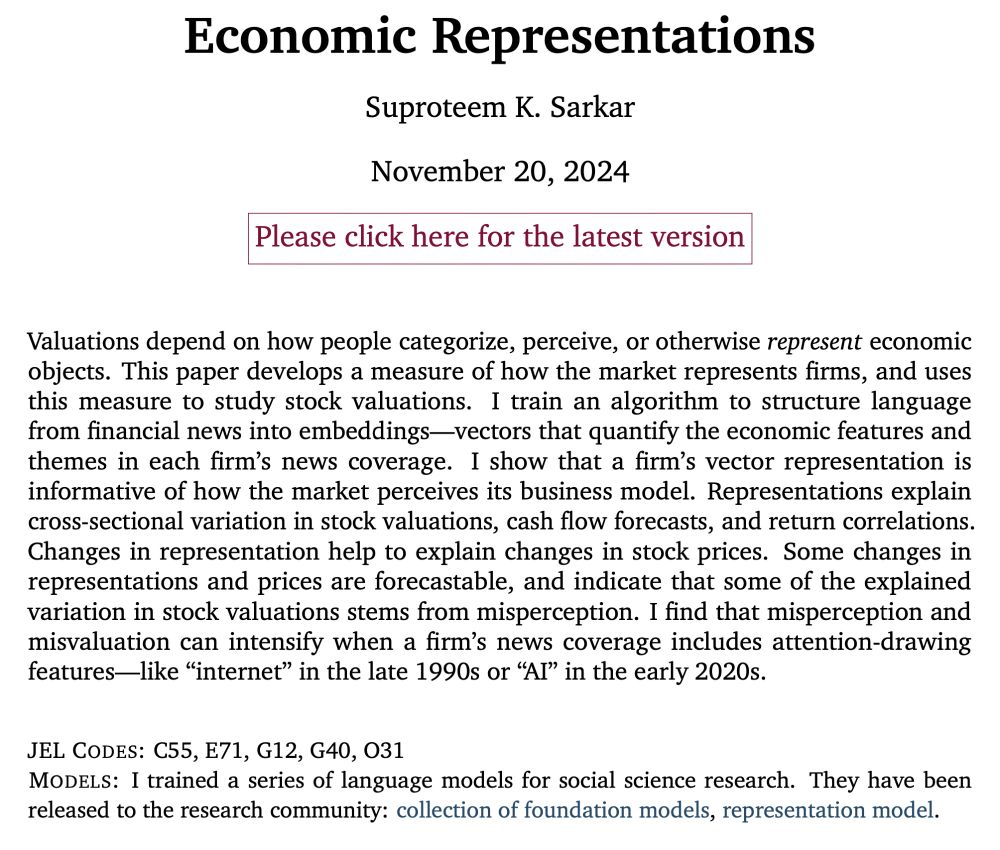
Abstract of paper
Economic valuations fluctuate in ways empirical research cannot fully explain
What information are we missing? Economic theories emphasize the role of hard-to-quantify beliefs and perceptions
My job market paper develops algorithms + measurement to quantify perceptions of firms
20.11.2024 20:06 — 👍 18 🔁 8 💬 1 📌 1
I am on the job market, which seems like a great opportunity for my first post on here! My job market paper is about failures of contingent thinking -- the act of reasoning about hypothetical events. 1/
20.11.2024 16:03 — 👍 129 🔁 29 💬 7 📌 10
I’m curious whether DeFi legality affects contributions. And time zone would for sure be a useful predictor! (It’s for sure at least somewhat predictive of country on GitHub.) Useful to hear that there’s probably no low hanging fruit for wallet geocoding - thanks.
20.11.2024 01:44 — 👍 0 🔁 0 💬 0 📌 0
Legality of geocoding wallets? Makes sense. Best public data I could find from a quick search is a coarse proxy involving web traffic (documents1.worldbank.org/curated/en/7...).
19.11.2024 22:28 — 👍 0 🔁 0 💬 1 📌 0
Thanks, Gina! Given your research, I'm curious if you think some comparable spillover stats could be measured for crypto OSS at the country level? E.g., comparing crypto GitHub contributions by country to transaction volumes for geocode-able (?) wallets?
19.11.2024 14:46 — 👍 0 🔁 0 💬 1 📌 0
GH Archive
GH Archive is a project to record the public GitHub timeline, archive it, and make it easily accessible for further analysis.
Probably a lot of the questions are the same! A big thing that's changed is the increasing availability of incredible datasets like www.gharchive.org and innovationgraph.github.com
18.11.2024 23:16 — 👍 3 🔁 0 💬 0 📌 0
thanks Shosh!
18.11.2024 23:00 — 👍 1 🔁 0 💬 0 📌 0
Jeff Gortmaker
Jeff Gortmaker, Ph.D. candidate in Business Economics at Harvard University, specializing in industrial organization, with secondary interestes in econometrics and finance.
18/18 This has been a joy to write and present (not only because I get to use PyBLP screenshots to illustrate US-China collaboration).
I'm excited to keep studying the tech sector from an IO perspective, and building econometric tools on the way.
Links: jeffgortmaker.com
18.11.2024 19:23 — 👍 4 🔁 0 💬 0 📌 0
17/ Subsidies seem more effective and generate large innovation spillovers, especially if the US responds in kind.
Subsidies can be cheap because OSS investment is rare (weak private benefits), but impactful because OSS use is widespread (strong public benefits).
18.11.2024 19:23 — 👍 2 🔁 0 💬 1 📌 0
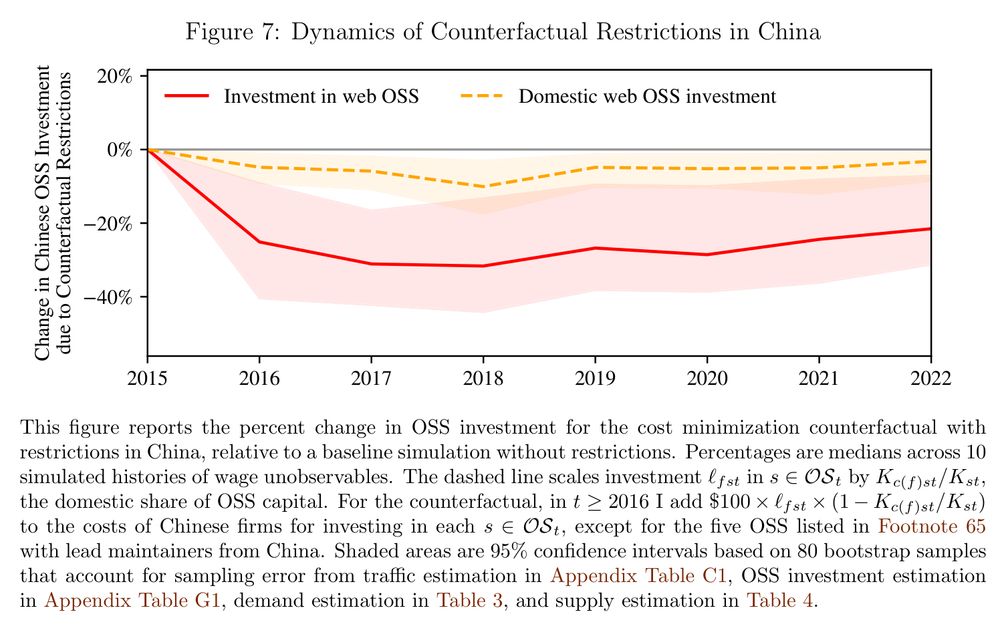
16/ What if China tightened its restrictions?
Benefits don't seem localized enough for a "tax" on foreign collaboration to boost domestic OSS investment. Instead, lost spillovers raise web development costs globally.
18.11.2024 19:23 — 👍 1 🔁 0 💬 1 📌 0
15/ These estimates are key inputs into my policy simulations.
Weak private benefits may justify subsidies that reduce underprovision, while strongly localized benefits may justify policies that coordinate domestic investment.
18.11.2024 19:23 — 👍 1 🔁 0 💬 1 📌 0
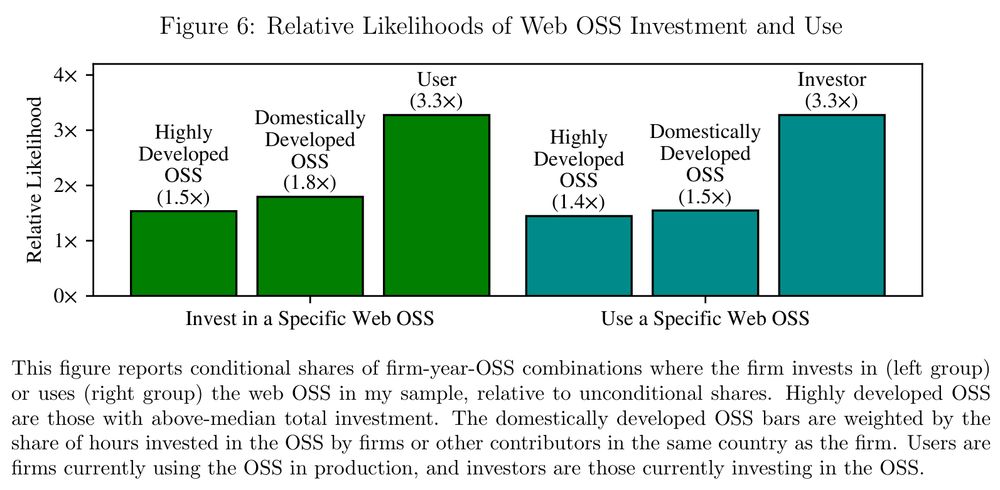
14/ Subject to the production function, firms' cost-minimizing choices reveal web development costs.
Firms prefer OSS with more, own, and domestic investment. The model translates these patterns into public, private, and localized benefits of OSS investment.
18.11.2024 19:23 — 👍 1 🔁 0 💬 1 📌 0
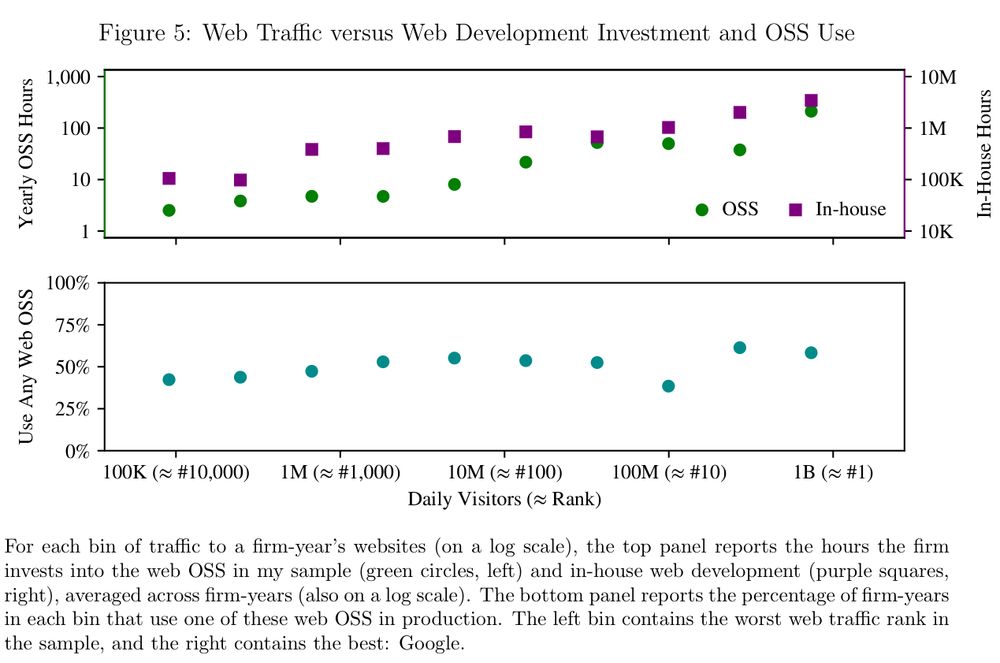
13/ I estimate website quality's production function using timing assumptions.
A weak link between OSS use and traffic translates into a weak effect of OSS use on quality, limiting the effect of OSS on competition and consumers in policy simulations.
18.11.2024 19:23 — 👍 1 🔁 0 💬 1 📌 0

12/ Consumers choose websites based on country, language, and quality.
I get to use my own OSS PyBLP to estimate demand! I find strong "home bias," limiting international competition in policy simulations.
18.11.2024 19:23 — 👍 5 🔁 0 💬 1 📌 0
Assistant Professor, Accounting and Information Systems, Rutgers Business School, Newark, NJ
PhD Economist at Cambridge Judge Business School and King's College Cambridge
IO economist at the Congressional Budget Office. Work on drug pricing, vertical contracting and innovation.
https://sites.google.com/site/christopherpadams/
Book: Learning Microeconometrics with R
New Book: Game Theory for Applied Econometrician
Assistant professor, HKUST Business School
Geoeconomics, trade, finance
Research faculty at Leeds School of Business, CU-Boulder. https://mjyang.com/ Researching Scientific Entrepreneurship, Technological Uniqueness, and AI #scientificentrepreneurship, #strategy, #innovation
Faculty in the strategy group at Olin Business School at Washington University in Saint Louis, studying human capital and entrepreneurship. https://sites.google.com/view/sethcarnahan
PhD candidate @HarvardEcon. I study cities and their regulations. Proud dog mom to Dexter.
Marketing Professor at Yale
Labor Economist @ Temple University
I think a lot about how the economic conditions you face when you first enter the labor market affect long run outcomes.
RPCV (Uganda 2011), Gold Star family member, and Philly Sports fan.
http://www.joshmask.com
PhD Candidate in Economics at Princeton University
Assoc. Prof. Econ @bostoncollege.bsky.social studying behavioral industrial organization #EconSky
Senior Economist at the Census Bureau
Macro Labor, Market Power, and Firm Dynamics
Views are my own
Assistant Professor of Economics at Chicago Booth. @NYUniversity Econ PhD. I use IO tools to study the best human invention: cities.
Researcher @rockwoolfonden.dk
Interested in IO, Competition Economics, Applied Microeconomics, PhD from @dice-hhu.bsky.social @hhu.bsky.social
www.anjaroesner.com
Assistant Professor of Economics at the University of Utah. Senior Fellow in Higher Education Finance, Jain Family Institute. Aging enfant terrible.
Economics, Business, and Energy Prof at UC Berkeley. Member, Board of Governors, CA ISO. All opinions only my own.













